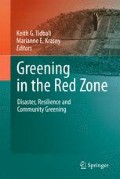Abstract
In addition to their more recognized ecosystem service functions, urban forests are valued for the cherished meanings and memories they symbolize. Residents draw emotional strength from the stories, people, and events associated with trees. Disaster and disturbance events that destroy the urban forest therefore threaten and damage residents’ attachment to place, and perhaps even their sense of identity. The symbolic qualities of the urban forest even may motivate community response and resilience to hazards. Implications for planning and maintenance of urban tree canopy are discussed.
Access this chapter
Tax calculation will be finalised at checkout
Purchases are for personal use only
Notes
- 1.
Journal of Arboriculture 18(2): March 1992 and is used by permission.
References
Belk, R. W. (1988). Possessions and the extended self. Journal of Consumer Research, 15, 139–168.
Czikszentmihalyi, M., & Rochberg-Halton, E. (1981). The meaning of things: domestic symbols and the self. Cambridge: Cambridge University Press.
Hull, R. B. (1992). Image congruity, place attachment and community design. Journal of Architecture and Planning Research, 9, 181–192.
Hull, R. B. (2006). Infinite nature. Chicago: University of Chicago Press.
Hull, R. B., & Michael, S. E. (1994). Nature based recreation, mood change, and stress restoration. Leisure Sciences, 17, 1–14.
Hull, R. B., Lam, M., & Vigo, G. (1994). Place identity: Symbols of self in the urban fabric. Landscape and Urban Planning, 28, 109–120.
Hull, R. B., Michael, S. E., Walker, G. J., & Roggenbuck, J. W. (1996). Ebb and flow of brief leisure experiences. Leisure Sciences, 18, 299–314.
Jacobi, M., & Stokols, D. (1983). The role of tradition in group environment situations. In N. R. Feimer & E. S. Geller (Eds.), Environmental psychology: Directions and perspectives. New York: Prager Press.
Korpela, K. M. (1989). Place-identity as a product of environmental self-regulation. Journal of Environmental Psychology, 9, 241–256.
Lynch, K. (1960). The image of the city. Cambridge, MA: MIT Press.
McMillan, D. W., & Chavis, D. (1986). Sense of a community: A definition and theory. Journal of Community Psychology, 14(1), 6–23.
McPherson, E. G., James, R., Peper, P., Maco, S., & Xiao, Q. (2005). Municipal forest benefits and costs in five US cities. Journal of Forestry, 103(8), 411–416.
Mole, G., & Ebenreck, S. (1989). Shading our cities: A resource guide for urban and community forests. Washington, DC: Island Press.
Nowak, D. J., & Dwyer, J. F. (2007). Understanding the benefits and costs of urban forest ecosystems. In J. E. Kuser (Ed.), Urban and community forestry in the northeast. Netherlands: Springer.
Proshansky, H. M., Fabian, A. K., & Kaminoff, R. (1983). Place identity: Physical world socialization of the self. Journal of Environmental Psychology, 3, 57–83.
Rivlin, L. G. (1987). The neighborhood, personal identity, and group affiliations. In I. Altman & A. Wandersman (Eds.), Neighborhood and community environments. New York: Plenum Press.
Sack, R. D. (1988). The consumer’s world: Place as context. Annals of the Association of American Geographers, 78, 642–666.
Shaver, P., Schwartz, J., Kirson, D., & O’Connor, C. (1987). Emotion knowledge: Further exploration of a prototype approach. Journal of Personality and Social Psychology, 52, 1061–1086.
Shumaker, S. A., & Taylor, R. B. (1983). Towards a clarification of people-place relationships: A model of attachment to place. In N. R. Feimer & E. S. Geller (Eds.), Environmental psychology: Directions and perspectives. New York: Prager Press.
Smardon, R. C. (1988). Perception and aesthetics of the urban environment: Review of the role of vegetation. Landscape and Urban Planning, 15, 85–106.
Stokols, D. (1981). Group x place transactions: Some neglected issues in psychological research on settings. In D. Magnusson (Ed.), Towards a psychology of situations: An interactional perspective. Hillsdale: Lawrence Erlbaum.
Tidball, K. G., Krasny, M. E., et al. (2010). Stewardship, learning, and memory in disaster resilience. Environmental Education Research (Special Issue, Resilience in social-ecological systems: The role of learning and education), 16(5), 341–357.
Tuan, Y. (1980). The significance of artifact. Geographical Review, 70, 462–472.
Wolf, K. L. (2005). Business district streetscapes, trees, and consumer response. Journal of Forestry, 8(December), 396–400.
Author information
Authors and Affiliations
Corresponding author
Editor information
Editors and Affiliations
Rights and permissions
Copyright information
© 2014 Springer Science+Business Media Dordrecht
About this chapter
Cite this chapter
Hull, R.B. (2014). Valuing Urban Forest: Lessons to Learn from Hurricanes. In: Tidball, K., Krasny, M. (eds) Greening in the Red Zone. Springer, Dordrecht. https://doi.org/10.1007/978-90-481-9947-1_19
Download citation
DOI: https://doi.org/10.1007/978-90-481-9947-1_19
Published:
Publisher Name: Springer, Dordrecht
Print ISBN: 978-90-481-9946-4
Online ISBN: 978-90-481-9947-1
eBook Packages: Earth and Environmental ScienceEarth and Environmental Science (R0)

